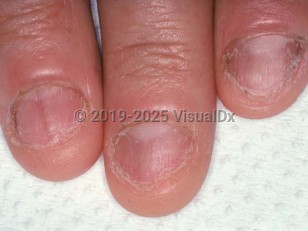Nail biting - Nail and Distal Digit
Alerts and Notices
Important News & Links
Synopsis

Onychophagia describes a habit of nail biting in which the nails and adjacent skin are chewed. The fingernails are the preferred site, although occasionally the toenails are involved. Patients usually bite the nails on both hands.
Nail-biting behavior can be made worse when the patient is anxious, bored, or working on complex tasks. It improves with social interaction. It may also improve when the behavior is pointed out.
Nail biting often begins in childhood or adolescence, but cases of adult-onset nail biting do occur. Nail-biting behavior typically lasts for approximately 10 years; however, it may persist into adulthood.
Onychophagia may be associated with an underlying psychiatric disease such as obsessive-compulsive disorder, anxiety disorder, impulse control disorder, anorexia nervosa, or bulimia nervosa. There is a partial genetic component of onychophagia, as many nail biters have at least one family member with this habit.
Onychophagia has a negative effect on quality of life. Nails tend to be both very short and uneven. In more severe cases, cuticles are absent or ragged and nail folds are frayed. Splinter hemorrhages are common findings. Sequelae include increased rate of nail plate growth, shortening and disappearance of the nail bed, longitudinal melanonychia, and paronychia. Oral complications are gingival swelling, malocclusion of the teeth, temporomandibular joint syndrome, and infections following oral surgery.
Rare complications are osteomyelitis and herpetic whitlow.
Onychophagia may facilitate the spread of verruca.
Related topics: onychotillomania, trichotillomania
Nail-biting behavior can be made worse when the patient is anxious, bored, or working on complex tasks. It improves with social interaction. It may also improve when the behavior is pointed out.
Nail biting often begins in childhood or adolescence, but cases of adult-onset nail biting do occur. Nail-biting behavior typically lasts for approximately 10 years; however, it may persist into adulthood.
Onychophagia may be associated with an underlying psychiatric disease such as obsessive-compulsive disorder, anxiety disorder, impulse control disorder, anorexia nervosa, or bulimia nervosa. There is a partial genetic component of onychophagia, as many nail biters have at least one family member with this habit.
Onychophagia has a negative effect on quality of life. Nails tend to be both very short and uneven. In more severe cases, cuticles are absent or ragged and nail folds are frayed. Splinter hemorrhages are common findings. Sequelae include increased rate of nail plate growth, shortening and disappearance of the nail bed, longitudinal melanonychia, and paronychia. Oral complications are gingival swelling, malocclusion of the teeth, temporomandibular joint syndrome, and infections following oral surgery.
Rare complications are osteomyelitis and herpetic whitlow.
Onychophagia may facilitate the spread of verruca.
Related topics: onychotillomania, trichotillomania
Codes
ICD10CM:
L60.8 – Other nail disorders
SNOMEDCT:
37298006 – Nail biting
L60.8 – Other nail disorders
SNOMEDCT:
37298006 – Nail biting
Look For
Subscription Required
Diagnostic Pearls
Subscription Required
Differential Diagnosis & Pitfalls

To perform a comparison, select diagnoses from the classic differential
Subscription Required
Best Tests
Subscription Required
Management Pearls
Subscription Required
Therapy
Subscription Required
References
Subscription Required
Last Reviewed:02/02/2017
Last Updated:09/11/2023
Last Updated:09/11/2023
 Patient Information for Nail biting - Nail and Distal Digit
Patient Information for Nail biting - Nail and Distal Digit
Premium Feature
VisualDx Patient Handouts
Available in the Elite package
- Improve treatment compliance
- Reduce after-hours questions
- Increase patient engagement and satisfaction
- Written in clear, easy-to-understand language. No confusing jargon.
- Available in English and Spanish
- Print out or email directly to your patient
Upgrade Today

Nail biting - Nail and Distal Digit

